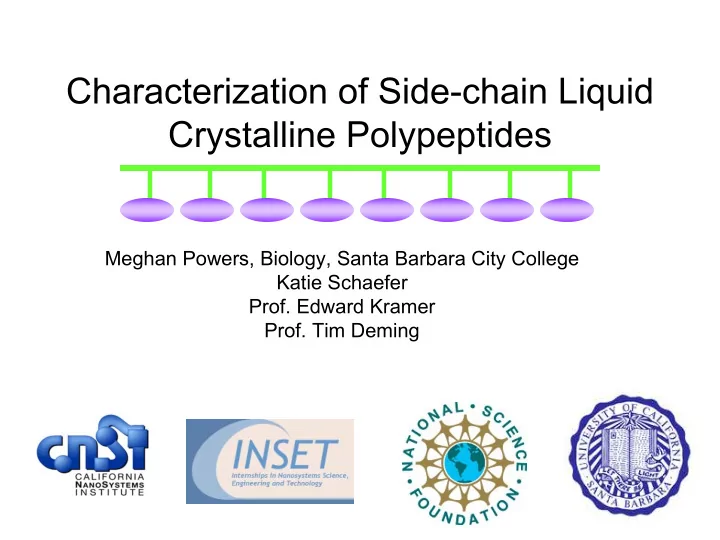

Characterization of Side-chain Liquid Crystalline Polypeptides Meghan Powers, Biology, Santa Barbara City College Katie Schaefer Prof. Edward Kramer Prof. Tim Deming
• Project Description Characterization of the thermotropic mesogen and of the poly(L-lysine) backbone as separate components in order to understand the thermal dependence of liquid crystal transitions. • Techniques Differential Scanning Calorimetry Optical Microscopy
Liquid Crystals a thermodynamic stable phase characterized by anisotropy of properties generally lying in the temperature range between the solid and isotropic liquid phase http://plc.cwru.edu/tutorial/enhanced/files/textbook.htm Anisotropic : Having properties which vary depending on the direction of measurement. Birefringence: anisotropic optical properties
Structure of Polypeptide •Backbone: Lysine •Spacer: (CH 2 ) n n= 3,5,10 •Mesogen: liquid crystalline material O C 4 H 9 O O O OC 4 H 9 O O O Spacer
Differential Scanning Calorimetry http://www.psrc.usm.edu/macrog/dsc.htm Polarized Optical Microscopy Used to observe birefringence in crystalline or liquid crystalline materials in order to detect phase changes.
DSC Analysis of Mesogen 0 -1 Heat flow W/g -2 -3 -4 0 50 100 150 200 o C) Temperature (
Optical Analysis (10X) of Poly(Z-lys) 40°C 80°C 60°C 120°C 155°C 103°C
Characteristics of Mesogen • Low temperature anisotropic phases melt into isotropic liquid • Formation of hard crystalline structures after cooling Characteristics of Poly(Z-lys) • Hard glassy properties below glass transition • Structure becomes rubbery above Side Chain LC Polypeptides glass transition, no melting point 0.4 Characteristics of 0.2 Homopolymers Heat flow (W/g) PLM3 PLM5 • Glassy below T g , rubbery above T g 0.0 PLM10 • Anisotropic liquid crystalline phases -0.2 characteristic of mesogen -0.4 • Thermal transitions are reversible 0 50 100 150 o C) Temperature (
Future Plans DSC on Poly(Z-lys) X-ray diffraction on components and homopolymers Synthesis of random copolymers of lysine and mesogenic lysine Acknowledgments Katie Schaefer The Kramer Group Ed Kramer The Deming Group Krystyna Brzezinska INSET
Polarized Optical Microscopy Used to observe birefringence in crystalline or liquid crystalline materials in order to detect phase changes. Black Sample Background Incident Birefringence Light Image Polarizer Analyzer Support
DSC Rate Analysis of Plm-10 93.8°C 10°C/min 0.4 95.5 °C 5°C/min 0.2 Heat flow W/g 97.8 °C 1°C/min 0.0 103.2°C 103.0 °C -0.2 102.7 °C 80 90 100 110 120 o C) Temperature (
Recommend
More recommend